Probably my favourite place to research in London was the Liddell Hart Centre for Military Archives at King's College London, where I spent the better part of two weeks digging through several personal archives. It's a very pleasant environment to work in, and the staff were very helpful in accommodating this rude colonial's requests, even at short notice! (Plus they actually sent me the roughly 200 pages of photocopies I ordered; I still haven't got the batch I ordered from the British Library, and quite possibly won't now, since it shouldn't take a month to arrive by airmail ...) KCL lies between Strand and the Victoria Embankment, near Waterloo Bridge; I'd usually take the Tube to Embankment and walk up from there, keeping my eye out for anything interesting along the way ...
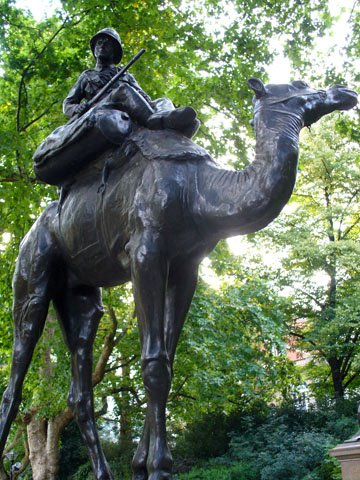
This is the Imperial Camel Corps memorial in Victoria Embankment Gardens. I've previously written about a relative who was in the ICC and knew there was a memorial to it in London (in itself a bit odd, as most of them were Australians), which I vaguely thought I should seek out while I was there. Turns out I didn't have to as I stumbled across it completely by chance! It's quite a striking -- though incongruous, amid all the green -- statue, though the photo probably exaggerates the size of it.

Also in the same gardens is the memorial to Arthur Sullivan -- as in Gilbert and Sullivan. Given his numerous love affairs, the form of the memorial seems most appropriate! I wonder whether that was intentional? Not that the Victorians and Edwardians (Sullivan died in 1900) were as buttoned-down as they are popularly thought to be, but it does seem to be a surprisingly blunt sexual allusion.
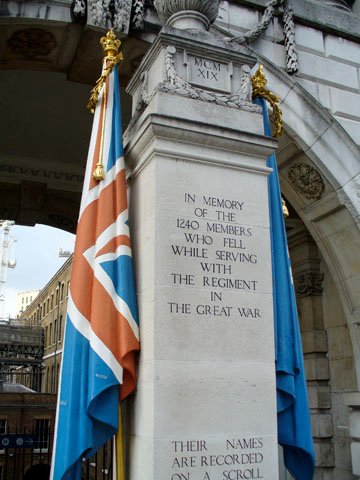
Outside Somerset House is this rather splendid memorial to those members of 15th (County of London) Battalion, The London Regiment (Prince of Wales's Own, Civil Service Rifles) who were killed in the First World War. The flags are made of copper and presumably need to be repainted fairly regularly!

Yet another First World War memorial; this time it's to the Royal Navy's submariners lost in the war (though it also lists the Australian AE1 and AE2).
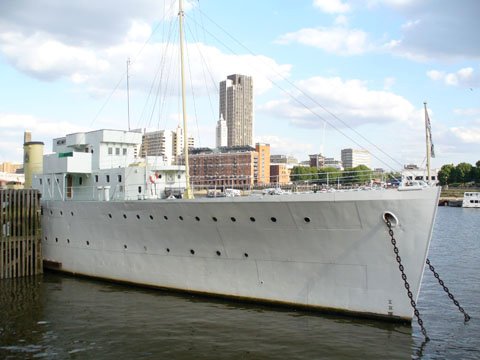
A ship anchored in the Thames. Nothing too unusual about that -- except this one doesn't go anywhere. It's permanently moored here and serves as the headquarters of the Honourable Company of Master Mariners. (Personally I'd prefer something less likely to sink ... but then, I'm not a master mariner.) As HMS Wellington, a Grimsby-class sloop, it did service as a convoy escort in the Second World War, and took part in Operation Dynamo, among other things.
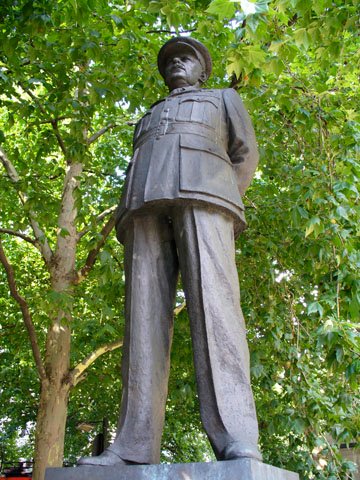
Now, moving on to the Strand. Out in front of St Clement Danes, the RAF's central church (which, again I'd intended to have a look at, but found by accident), is this statue of Marshal of the RAF Arthur Harris, head of Bomber Command 1942-5. It's the one which protesters jeered when it was unveiled by the Queen Mum in 1992.
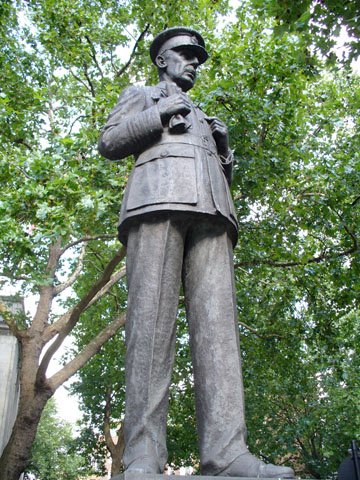
Nearby is the rather less controversial Air Chief Marshal Sir Hugh Dowding, head of Fighter Command 1936-40.
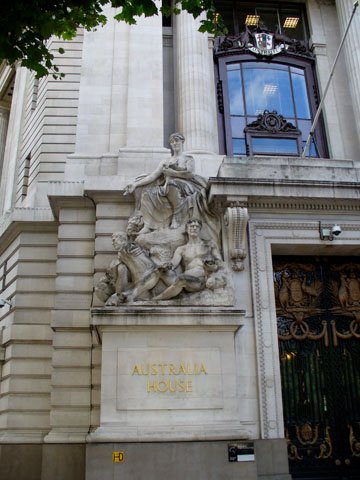
Directly opposite St Clement Danes is this reminder of home -- Australia House. Apparently the longest-occupied embassy in London, though since it was only opened in August 1918 that's not actually very long. The statue group, by Harold Parker, is either called Awakening of Australia or Prosperity of Australia (there's another one on the opposite side of the door), either way it doesn't do much for me.
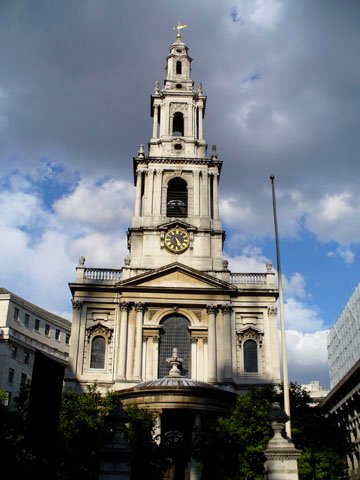
Lastly, St Mary le Strand, the second "island church" -- because surrounded by roads on all sides -- St Clement Danes being the other. It was consecrated in 1723, on the site of a famous maypole. The maypole (or perhaps only its base) was bought by Isaac Newton as part of what would have been the world's largest telescope, at Wanstead Park in Essex, a tubeless refractor using a 7.5-inch diameter, 123-foot focal length objective lens donated to the Royal Society by Christiaan Huygens. Though the optics were not good enough for serious work, some wag approved of the maypole's new role, for one morning the following verses were found affixed to it (so it is said):
Once I adorned the Strand,
But now have found
My way to Pound
On Baron Newton's land;
Where my aspiring head aloft is reared,
T' observe the motions of th' ethereal Lord.
Here sometimes raised a machine by my side,
Through which is seen the sparkling milky tide;
Here oft I'm scented with a balmy dew,
A pleasant blessing which the Strand ne'er knew.
There stood I only to receive abuse,
But here converted to a nobler use;
So that with me all passengers will say,
'I'm better far than when the Pole of May.'
I really didn't plan to write about the role played by pagan survivals in the development of modern science when I started this post ...
![]() This work is licensed under a Creative Commons Attribution-NonCommercial-NoDerivatives 4.0 International License.
Permissions beyond the scope of this license may be available at http://airminded.org/copyright/.
This work is licensed under a Creative Commons Attribution-NonCommercial-NoDerivatives 4.0 International License.
Permissions beyond the scope of this license may be available at http://airminded.org/copyright/.

Alan Allport
Apparently the longest-occupied embassy in London ...
Tut-tut. None of that 'embassy' stuff at a Dominion High Commission, shurely? (Although I notice with some disappointment AH's URL).
Alex
Note: a campaign is being got up for a statue of Sir Keith Park somewhere in London, notably by City potentate Terry Smith..
Brett Holman
Post authorAlan:
Fair point! That's probably why their website says "longest continuously occupied foreign mission".
Alex:
On the one hand, it's hard to argue that Park is undeserving of a statue. On the other, just how many statues does one city need?? You've got more than a few already ...
Roger Todd
"I still haven’t got the batch I ordered from the British Library, and quite possibly won’t now, since it shouldn’t take a month to arrive by airmail..."
If it's not in transit now, then God knows when you'll get it as the good old Royal Mail are on strike for the best part of the next week, which will cause untold chaos for much longer than the strike period...
You're right about the LHCMA, it's a splendid little place. I work in an office on the floor beneath (practically directly below it, in fact) and sometimes pop up there to dig about this and that.
You mention their efficiency at actually posting your stuff to you, but I must trumpet your home country's Australian War Memorial. Last year I ordered a batch of 80-odd photocopied pages from them. The service, carried out entirely online, was friendly, cheap and damn fast - hurrah for the rude colonials!
Brett Holman
Post authorIf I'd known I would have popped down to say hello!
"The service, carried out entirely online, was friendly, cheap and damn fast - hurrah for the rude colonials!"
Then the AWM is 3 up on the BL ...
Jack
Postal strike, tube strikes, Labour Prime Minister hitherto considered a 'safe pair of hands' dithers then declines to call a General Election... I think you got home just before we reverted to 1978.
Gavin Robinson
Does that mean Jilted John will be back in the charts?
Brett Holman
Post authorJack:
Well, if so then you read it here first :)
Gavin:
I don't think we got that down here, and having googled it and listened to it, I can't say that's a bad thing!
Chris Williams
Jilted John now plays a Bontempi organ in old peoples' homes throughout South Yorkshire. See: http://www.shuttleworths.co.uk/ and http://en.wikipedia.org/wiki/Graham_Fellows
Brett Holman
Post authorWell, I must apologise to the BL: I got the photocopies today, a bit over 5 weeks since I put in the order. Luckily I didn't actually need them in a hurry. In fact I probably won't even look at them for another 6 months ...
Brett Holman
Post authorOh, and on the matter of elections ... can somebody get a copy of the Australian constitution to the editor of the Daily Telegraph asap? They're lauding John Howard for his bravery in calling an election when behind in the polls (to be contrasted with cowardly Gordon Brown, of course). When in fact Parliament's term is nearly up and Howard had to call one by (I think) 2 January 2008 -- so he could have waited another 6 weeks or so, at most.
Mrs. M. Stock
I would like to add my name to this campaign. Why not have a memorial to a great hero of England,
ken mikowski
as a reply to ure queries about the imperial camel corps, there was a detachment of royal marines that served as a company of the guards camel corps during the march to relieve Khartoum, sudan 1884, i belive this corps had a strength 1,800 men and this might well be the imperial camel corps
Brett Holman
Post authorThanks, Ken, I didn't know about the earlier camel corps! But the memorial in the Victoria Embankment Gardens is definitely for the First World War Imperial Camel Corps, it says so on the memorial itself.
Pingback:
Whose statue should go on the 4th plinth in Trafalgar Square? « Kings of War
Pingback:
Victoria Embankment Gardens | London Parks & Gardens